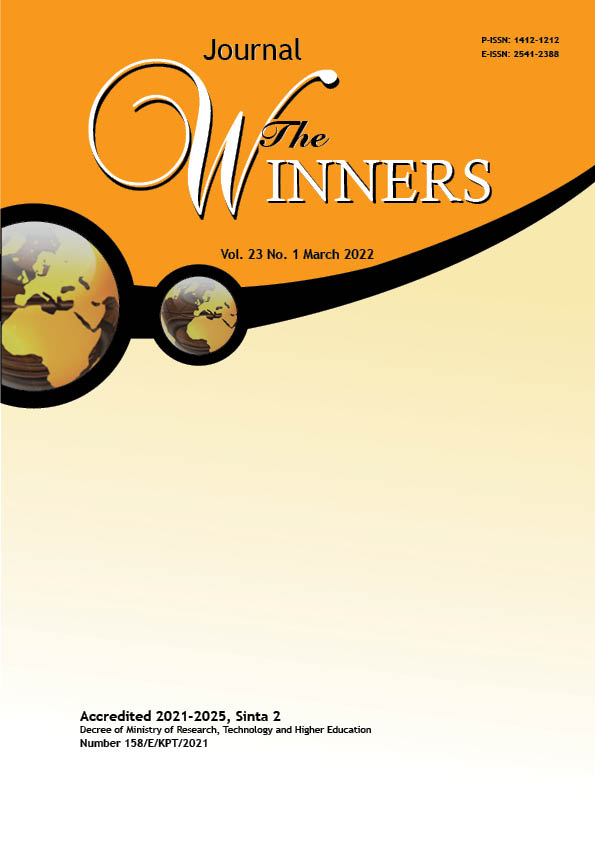Evaluating Perceived Service Quality, Perceived Playfulness, and Gratification towards User’s Attitude of Mobile Instant Messaging Application
DOI:
https://doi.org/10.21512/tw.v23i1.7089Keywords:
gratification model, mobile instant messaging, perceived playfulness, perceived service qualityAbstract
The research aimed to understand the behavior and adoption of mobile instant messaging (MIM) usage. By applying perceived service quality towards perceived playfulness and gratification model, the research investigated the factors related to MIM usage. Two most popular MIM applications used in Semarang, Indonesia, namely WhatsApp and LINE were targeted. After testing and validating the reliability and validity, questionnaires were distributed to university students and employees in Semarang, Indonesia whom already used MIM applications. The measurement of the constructs in the proposed model was confirmed with confirmatory factor analysis (CFA) to test the consistency of question items within each construct. The outcomes of the questionnaire were tested through structural equation modeling (SEM) to test whether the proposed constructs are confirmed to the designated model. Path coefficient and fit indices of the proposed conceptual model were also used to measure the possible relations between variables. The results show positive influences of perceived service quality, perceived playfulness, and gratification towards user’s attitude.
References
Al-Qaysi, N., Mohamad-Nordin, N., & Al-Emran, M. (2020). Employing the technology acceptance model in social media: A systematic review. Education and Information Technologies, 25(6). 4961-5502. https://doi.org/10.1007/s10639-020-10197-1
Arcand, M., PromTep, S., Brun, I., & Rajaobelina, L. (2017). Mobile banking service quality and customer relationships. International Journal of Bank Marketing, 35(7), 1066–1087. https://doi.org/10.1108/IJBM-10-2015-0150
Bautista, J. R. & Lin, T. T. C. (2017). Nurses’ use of mobile instant messaging applications: A uses and gratifications perspective. International Journal of Nursing Practice, 23(5), 1–9. https://doi.org/10.1111/ijn.12577
Beldad, A. D. & Hegner, S. M. (2018). Expanding the technology acceptance model with the inclusion of trust, social influence, and health valuation to determine the predictors of German users’ willingness to continue using a fitness app: A structural equation modeling approach. International Journal of Human-Computer Interaction, 34(9), 882–893. https://doi.org/10.1080/10447318.2017.1403220
Bentler, P. M. & Bonnett, D. G. (1980). Significance tests and goodness of fit in the analysis of covariance structures. Psychological Bulletin, 88(3), 588–606. https://psycnet.apa.org/doi/10.1037/0033-2909.88.3.588
Chou, P. C. (2006). Understanding user’s perceived playfulness toward mobile information and entertainment services in New Zealand. [Master thesis]. Auckland University of Technology, New Zealand.
Chung, J. & Tan, F. B. (2004). Antecedents of perceived playfulness: An exploratory study on user acceptance of general information-searching websites. Information and Management, 41(7), 869–881. https://doi.org/10.1016/j.im.2003.08.016
Davis, F. D. (1989). Perceived usefulness, perceived ease of use, and user acceptance of information technology. MIS Quarterly, 13(3), 319–340. http://dx.doi.org/10.2307/249008
Ghazali, E. M., Mutum, D. S., & Woon, M. Y. (2019). Multiple sequential mediation in an extended uses and gratifications model of augmented reality game Pokémon Go. Internet Research, 29(3), 504–528. https://doi.org/10.1108/IntR-12-2017-0505
Ha, Y. W., Kim, J., Libaque-Saenz, C. F., Chang, Y., & Park, M. C. (2015). Use and gratifications of mobile SNSs: Facebook and KakaoTalk in Korea. Telematics and Informatics, 32(3), 425–438. https://doi.org/10.1016/j.tele.2014.10.006
Hsieh, S. H. & Tseng, T. H. (2017). Playfulness in mobile instant messaging: Examining the influence of emoticons and text messaging on social interaction. Computers in Human Behavior, 69, 405–414. https://doi.org/10.1016/j.chb.2016.12.052
Hung, S. Y., Tsai, J. C. A., & Chou, S. T. (2016). Decomposing perceived playfulness: A contextual examination of two social networking sites. Information and Management, 53(6), 698–716. https://doi.org/10.1016/j.im.2016.02.005
Karnowski, V., Leonhard, L., & Kümpel, A. S. (2018). Why users share the news: A theory of reasoned action-based study on the antecedents of news-sharing behavior. Communication Research Reports, 35(2), 91–100. https://doi.org/10.1080/08824096.2017.1379984
Moon, J. W. & Kim, Y. G. (2001). Extending the TAM for a World-Wide-Web context. Information and Management, 38(4), 217–230. https://doi.org/10.1016/S0378-7206(00)00061-6
Segars, A. H. & Grover, V. (1993). Re-examining perceived ease of use and usefulness: A confirmatory factor analysis. MIS Quarterly, 17(4), 517. https://doi.org/10.2307/249590
So, S. (2016). Mobile instant messaging support for teaching and learning in higher education. Internet and Higher Education, 31, 32–42. https://doi.org/10.1016/j.iheduc.2016.06.001
Soria, S., Gutiérrez-Colón, M., & Frumuselu, A. D. (2020). Feedback and mobile instant messaging: Using whatsapp as a feedback tool in EFL. International Journal of Instruction, 13(1), 797–812. https://doi.org/10.29333/iji.2020.13151a
Subrahmanyam, A. (2017). Relationship between service quality, satisfaction, motivation and loyalty. Quality Assurance in Education, 25(2), 171-188. http://dx.doi.org/10.1108/QAE-04-2013-0016
Tan, H. & Yan, M. (2020). Physician-user interaction and users’ perceived service quality: evidence from Chinese mobile healthcare consultation. Information Technology and People, 33(5), 1403–1426. https://doi.org/10.1108/ITP-01-2019-0039
Tarute, A., Nikou, S., & Gatautis, R. (2017). Mobile application driven consumer engagement. Telematics and Informatics, 34(4), 145–156. https://doi.org/10.1016/j.tele.2017.01.006
Vazquez, D., Dennis, C., & Zhang, Y. (2017). Understanding the effect of smart retail brand – Consumer communications via mobile instant messaging (MIM) – An empirical study in the Chinese context. Computers in Human Behavior, 77, 425–436. https://doi.org/10.1016/j.chb.2017.08.018
Yu, Z. (2020). Extending the learning technology acceptance model of WeChat by adding new psychological constructs. Journal of Educational Computing Research, 58(6), 1121–1143. https://doi.org/10.1177/0735633120923772
Downloads
Published
How to Cite
Issue
Section
License
Copyright (c) 2021 Prima Ayundyayasti, Arum Febriyanti Ciptaningtias

This work is licensed under a Creative Commons Attribution-ShareAlike 4.0 International License.
Authors who publish with this journal agree to the following terms:
a. Authors retain copyright and grant the journal right of first publication with the work simultaneously licensed under a Creative Commons Attribution License - Share Alike that allows others to share the work with an acknowledgment of the work's authorship and initial publication in this journal.
b. Authors are able to enter into separate, additional contractual arrangements for the non-exclusive distribution of the journal's published version of the work (e.g., post it to an institutional repository or publish it in a book), with an acknowledgment of its initial publication in this journal.
c. Authors are permitted and encouraged to post their work online (e.g., in institutional repositories or on their website) prior to and during the submission process, as it can lead to productive exchanges, as well as earlier and greater citation of published work.
USER RIGHTS
All articles published Open Access will be immediately and permanently free for everyone to read and download. We are continuously working with our author communities to select the best choice of license options, currently being defined for this journal as follows: Creative Commons Attribution-Share Alike (CC BY-SA)

















